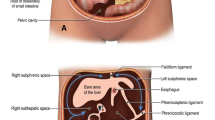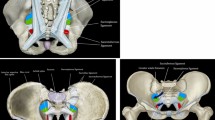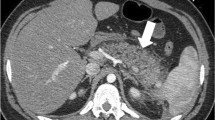Abstract
Pediatric handlebar injuries are a separate subset of unintentional injuries that need to be treated with a high degree of suspicion. They can be associated with varying underlying injuries which are often underestimated and cannot be predicted based on the external sign alone, thus leading to delayed diagnosis with missed injuries. In case 1, a 7-year-old boy presented a day after falling from his bicycle. Examination revealed a handlebar sign in the hypogastrium with guarding. Laparotomy revealed a jejunal perforation. In case 2, a 13-year-old boy presented with pain abdomen after being rammed by a bicycle handle. Examination revealed a handlebar sign in the lower part of the abdomen. He did not have any signs of peritonitis and was conservatively managed. In case 3, a 13-year-old boy with a history of fall from a bicycle sustained an abdominal handlebar injury. An impression of the handlebar was noted along with periumbilical tenderness and absent bowel sounds. Midline laparotomy revealed a walled-off collection of pus around a grade 3 duodenal laceration in the anterolateral aspect of the third part of the duodenum. In case 4, an 8-year-old boy presented after a fall while driving his bicycle with a handle imprint over the right upper quadrant. As the primary and secondary survey was normal, the child was managed conservatively. Handlebar injuries are apparently minor looking injuries with significant underlying impact on the underlying organs. These injuries must always be evaluated, and a low threshold must be kept for radiological investigations. Such children should be kept under observation for evolving signs of injury despite being seemingly normal.




Similar content being viewed by others
Data Availability
Not applicable.
References
Raveenthiran V (2018) The London sign (patterned bruising of blunt abdominal trauma). J Pediatr Surg 53(6):1252–1253
Winston FK, Shaw KN, Kreshak AA, Schwarz DF, Gallagher PR, Cnaan A (1998) Hidden spears: handlebars as injury hazards to children. Pediatrics 102(3):596–601
Neofytou K, Michailidou M, Petrou A, Loizou S, Andreou C, Pedonomou M (2013) Isolated jejunal perforation following bicycle handlebar injury in adults: a case report. Case reports in emergency medicine 5:2013
Hirose T, Ogura H, Kiguchi T, Mizushima Y, Kimbara F, Shimazaki J, Shiono S, Yamamura H, Wakai A, Takegawa R, Matsumoto H (2015) The risk of pediatric bicycle handlebar injury compared with non-handlebar injury: a retrospective multicenter study in Osaka, Japan. Scandinavian journal of trauma, resuscitation and emergency medicine 23(1):1–5
London PS. Practical guide to the care of the injured. Harcourt Brace/Churchill Livingstone; 1967.
Erez I, Lazar L, Gutermacher M, Katz S (2001) Abdominal injuries caused by bicycle handlebars. Eur J Surg 167(5):331–333
Stiekema J, Derikx JP (2018) Abdominal handlebar injury. JAMA Surg 153(2):179–180
Rathore A, Simpson BJ, Diefenbach KA (2012) Traumatic abdominal wall hernias: an emerging trend in handlebar injuries. J Pediatr Surg 47(7):1410–1413
Biyyam DR, Hwang S, Patel MC, Bardo DM, Bailey SS, Youssfi M (2020) CT findings of pediatric handlebar injuries. Radiographics 40(3):815–826
Fernández R, Bragagnini P, Álvarez N, Delgado R, Garcia JP, Escartín R, Gracia J (2015) Handlebar injury in children: are we ignoring the signs? J Pediatr Surg Case Rep 3(5):215–218
Gross JA, Vaughan MM, Johnston BD, Jurkovich G (2002) Handlebar injury causing pancreatic contusion in a pediatric patient. Am J Roentgenol 179(1):222
Arbogast KB, Cohen J, Otoya L, Winston FK (2001) Protecting the child’s abdomen: a retractable bicycle handlebar. Accid Anal Prev 33(6):753–757
Klin B, Rosenfeld-Yehoshua N, Abu-Kishk I, Efrati Y, Kozer E, Jeroukhimov I, Eshel G, Lotan G (2009) Bicycle-related injuries in children: disturbing profile of a growing problem. Injury 40(9):1011–1013
Clarnette TD, Beasley SW (1997) Handlebar injuries in children: patterns and prevention. Aust N Z J Surg 67(6):338–339
Chinmay SP, Kalavant AB (2021) Patterned abdominal wall bruise: an indicator of severe intra-abdominal injury. J Indian Assoc Pediatr Surg 26(2):136
Raveenthiran V, Bharath V (2020) Importance of the London sign in children. The Indian Journal of Pediatrics 16:1–2
So, Hang-Fai, and Hajir Nabi. “Handlebar hernia - a rare complication from blunt trauma.” International Journal of Surgery Case Reports, vol. 49, 2018, pp. 118–20. DOI.org (Crossref), doi:https://doi.org/10.1016/j.ijscr.2018.06.003.
Harrington, Amanda W., et al. “Doxycycline sclerotherapy for post-traumatic inguinal lymphocele in a child.” BMJ Case Reports, Jan. 2018, p. bcr-2017–222795. DOI.org (Crossref), doi:https://doi.org/10.1136/bcr-2017-222795.
Nguyen, Minh Hung, et al. “A 6-year-old boy presenting with traumatic evisceration following a bicycle handle bar injury: a case report.” Cases Journal, vol. 2, no. 1, 2009, p. 6315. DOI.org (Crossref), doi:https://doi.org/10.4076/1757-1626-2-6315.
Shukla, Ankit, et al. “Handlebar hernia with triple herniation and perforation: a case report and literature review.” Bulletin of Emergency and Trauma, vol. 6, no. 3, June 2018, pp. 257–61. DOI.org (Crossref), doi:https://doi.org/10.29252/beat-060313.
Mehta, M. H., et al. “Intramural duodenal hematoma following blunt bicycle handle bar injury.” The Indian Journal of Pediatrics, vol. 60, no. 6, Nov. 1993, pp. 836–38. DOI.org (Crossref), doi:https://doi.org/10.1007/BF02751064.
Klimek PM, Lutz T, Stranzinger E, Zachariou Z, Kessler U, Berger S (2013) Handlebar injuries in children. Pediatr Surg Int 29(3):269–273
Nadler EP, Potoka DA, Shultz BL, Morrison KE, Ford HR, Gaines BA (2005) The high morbidity associated with handlebar injuries in children. J Trauma Acute Care Surg 58(6):1171–1174
Sparnon AL, Ford WD (1986) Bicycle handlebar injuries in children. J Pediatr Surg 21(2):118–119
Nataraja RM, Palmer CS, Arul GS, Bevan C, Crameri J (2014) The full spectrum of handlebar injuries in children: a decade of experience. Injury 45(4):684–689
Karaman İ, Karaman A, Aslan MK, Erdoğan D, Çavuşoğlu YH, Tütün Ö (2009) A hidden danger of childhood trauma: bicycle handlebar injuries. Surg Today 39(7):572–574
Cherniawsky H, Bratu I, Rankin T, Sevcik W (2014) Serious impact of handlebar injuries. Clin Pediatr 53(7):672–676
Lam JP, Eunson GJ, Munro FD, Orr JD (2001) Delayed presentation of handlebar injuries in children. BMJ 322(7297):1288–1289
Vandewalle RJ, Barker SJ, Raymond JL, Brown BP, Rouse TM. Pediatric handlebar injuries: more than meets the abdomen. Pediatric emergency care. 2021 Jun 3.
Butt, Zunara. Retroperitoneal hematoma after bicycle handlebar blunt trauma to the abdomen. 2018. DOI.org (Datacite), 10.1594/EURORAD/CASE.15994.
Doley, Rudra Prasad. “Traumatic transection of pancreas at the neck: feasibility of parenchymal preserving strategy.” Gastroenterology Research, 2010. DOI.org (Crossref), doi:https://doi.org/10.4021/gr2010.02.163w.
Tytgat, S. H. A. J., et al. “Laparoscopic treatment of gastric and duodenal perforation in children after blunt abdominal trauma.” Injury, vol. 43, no. 9, Sept. 2012, pp. 1442–44. DOI.org (Crossref), doi:https://doi.org/10.1016/j.injury.2010.11.002.
Author information
Authors and Affiliations
Contributions
All authors contributed to the development of the manuscript and approved of the final submission.
Corresponding author
Ethics declarations
Ethics Approval and Consent to Participate
Informed consent taken.
Consent for Publication
Obtained.
Competing Interests
The authors declare no competing interests.
Additional information
Publisher’s Note
Springer Nature remains neutral with regard to jurisdictional claims in published maps and institutional affiliations.
Rights and permissions
About this article
Cite this article
Sehgal, M., Prasad, G., Dhua, A. et al. London Sign: More than Meets the Eye. Indian J Surg 84, 799–804 (2022). https://doi.org/10.1007/s12262-021-03090-9
Received:
Accepted:
Published:
Issue Date:
DOI: https://doi.org/10.1007/s12262-021-03090-9




